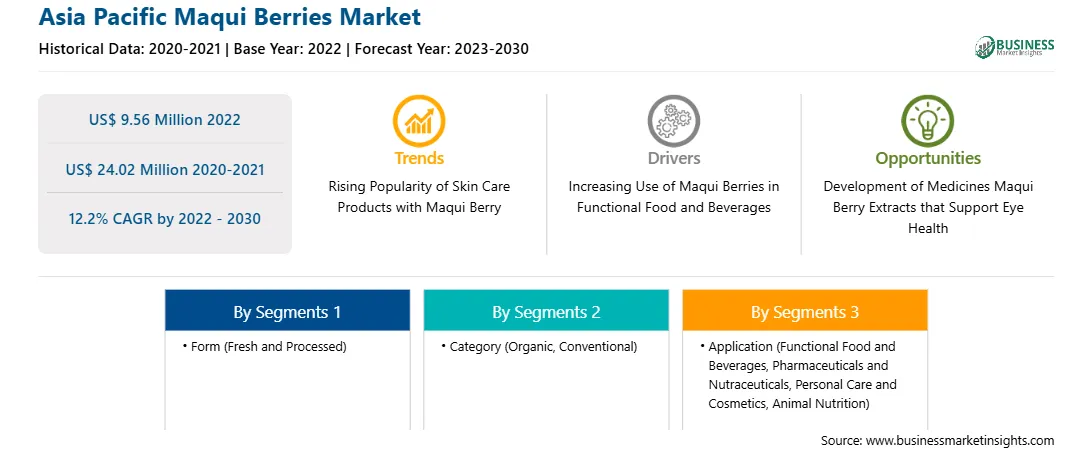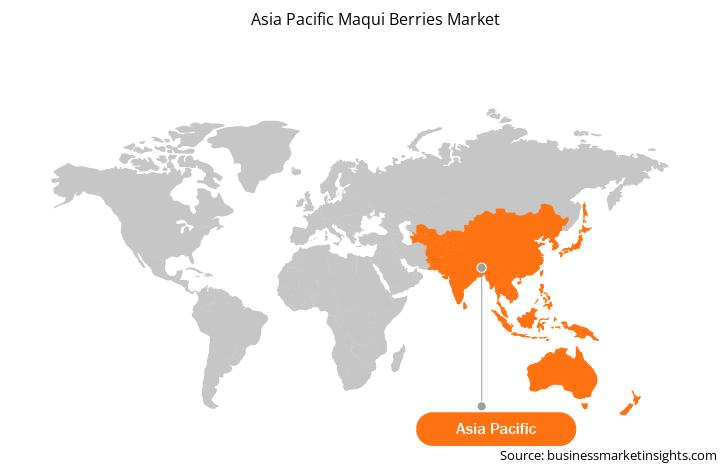The Asia Pacific maqui berries market is expected to grow from US$ 9.56 million in 2022 to US$ 24.02 million by 2030. It is estimated to record a CAGR of 12.2% from 2022 to 2030.
Development of Medicines with Maqui Berry Extracts that Support Eye Health Boosts Asia Pacific Maqui Berries Market
Dry eye happens when tear glands in the eyes do not make enough tears to stay wet and lubricated. This causes irritation in the eyes, redness, sensitivity to light, blurry vision, and a stinging or burning feeling. Dry eyes, if left untreated, can cause severe eye inflammation, corneal ulcers, abrasion of corneal surface, and vision loss. Since maqui berries are antioxidant-rich superfruits, it is seen that they can help reduce dry eye symptoms by reducing inflammation, increasing natural tear production, and improving tear quality.
In 2015, scientists in Japan discovered that oral medication made from maqui berry extracts can alleviate dry eye syndrome without using commercial eye drops. These oral supplements support healthy tear fluid generation and is a safer alternative to artificial tears. The company also conducted trials to see the effect of MaquiBright extract on dry eye discomfort. The participants reported significant improvement in tear production and dry eye discomfort. Thus, the rising development of innovative medicines and supplements with maqui berry extracts that support eye health is expected to open lucrative opportunities for the Asia Pacific maqui berry market in the coming years.
Asia Pacific Maqui Berries Market Overview
Asia Pacific is one of the emerging markets for maqui berries. The Asia Pacific maqui berries market is segmented into China, Japan, India, Australia, South Korea, and the Rest of Asia Pacific. Countries such as South Korea, Australia, and Japan are among the major importers of maqui berries. The dietary supplement manufacturers targeting eye health are increasingly using maqui berries in their products due to the presence of anthocyanins and flavonoids in maqui berries. Anthocyanins reduce oxidative stress in the retina, reduce inflammation, provide antiallergic and antimicrobial effects, and support blood circulation through fine capillaries in the eye. Thus, the demand for maqui berries is rising in the eye supplements space. In February 2021, Nano Japan, a beauty and health supplements company, launched Nano Optivue, a liquid supplement containing lutein, astaxanthin, maqui berry extract, blackcurrant, vitamin B, quercetin, and kuromanin-10. The company claims that the supplement can reduce digital eye strain and fatigue and improve focus. Nano Japan is planning to expand its geographical reach across Southeast Asia with the launch of its products in markets, including Singapore, Malaysia, and Japan.
Further, skin care products with maqui berries as a key ingredient are witnessing heavy demand in Asia Pacific countries, especially South Korea, India, and Australia. People in the region are focusing on natural skin care due to rising awareness of the harmful effects of toxic chemicals present in skin care products and cosmetics. The preference for berry-infused products is increasing significantly due to their brightening, purifying, and antiaging effects. This factor is expected to provide immense opportunities for the maqui berries market in Asia Pacific in the coming years.
Asia Pacific Maqui Berries Market Revenue and Forecast to 2030 (US$ Million)
Strategic insights for the Asia Pacific Maqui Berries provides data-driven analysis of the industry landscape, including current trends, key players, and regional nuances. These insights offer actionable recommendations, enabling readers to differentiate themselves from competitors by identifying untapped segments or developing unique value propositions. Leveraging data analytics, these insights help industry players anticipate the market shifts, whether investors, manufacturers, or other stakeholders. A future-oriented perspective is essential, helping stakeholders anticipate market shifts and position themselves for long-term success in this dynamic region. Ultimately, effective strategic insights empower readers to make informed decisions that drive profitability and achieve their business objectives within the market.

| Report Attribute | Details |
|---|---|
| Market size in 2022 | US$ 9.56 Million |
| Market Size by 2030 | US$ 24.02 Million |
| Global CAGR (2022 - 2030) | 12.2% |
| Historical Data | 2020-2021 |
| Forecast period | 2023-2030 |
| Segments Covered |
By Form
|
| Regions and Countries Covered | Asia-Pacific
|
| Market leaders and key company profiles |
The geographic scope of the Asia Pacific Maqui Berries refers to the specific areas in which a business operates and competes. Understanding local distinctions, such as diverse consumer preferences (e.g., demand for specific plug types or battery backup durations), varying economic conditions, and regulatory environments, is crucial for tailoring strategies to specific markets. Businesses can expand their reach by identifying underserved areas or adapting their offerings to meet local demands. A clear market focus allows for more effective resource allocation, targeted marketing campaigns, and better positioning against local competitors, ultimately driving growth in those targeted areas.

1. HP Ingredients Corp
2. Jeeva Organic Pvt Ltd
3. Shaanxi LonierHerb Bio-Technology Co Ltd
4. Xi'an Herb Bio-Tech Co Ltd
The Asia Pacific Maqui Berries Market is valued at US$ 9.56 Million in 2022, it is projected to reach US$ 24.02 Million by 2030.
As per our report Asia Pacific Maqui Berries Market, the market size is valued at US$ 9.56 Million in 2022, projecting it to reach US$ 24.02 Million by 2030. This translates to a CAGR of approximately 12.2% during the forecast period.
The Asia Pacific Maqui Berries Market report typically cover these key segments-
The historic period, base year, and forecast period can vary slightly depending on the specific market research report. However, for the Asia Pacific Maqui Berries Market report:
The Asia Pacific Maqui Berries Market is populated by several key players, each contributing to its growth and innovation. Some of the major players include:
The Asia Pacific Maqui Berries Market report is valuable for diverse stakeholders, including:
Essentially, anyone involved in or considering involvement in the Asia Pacific Maqui Berries Market value chain can benefit from the information contained in a comprehensive market report.